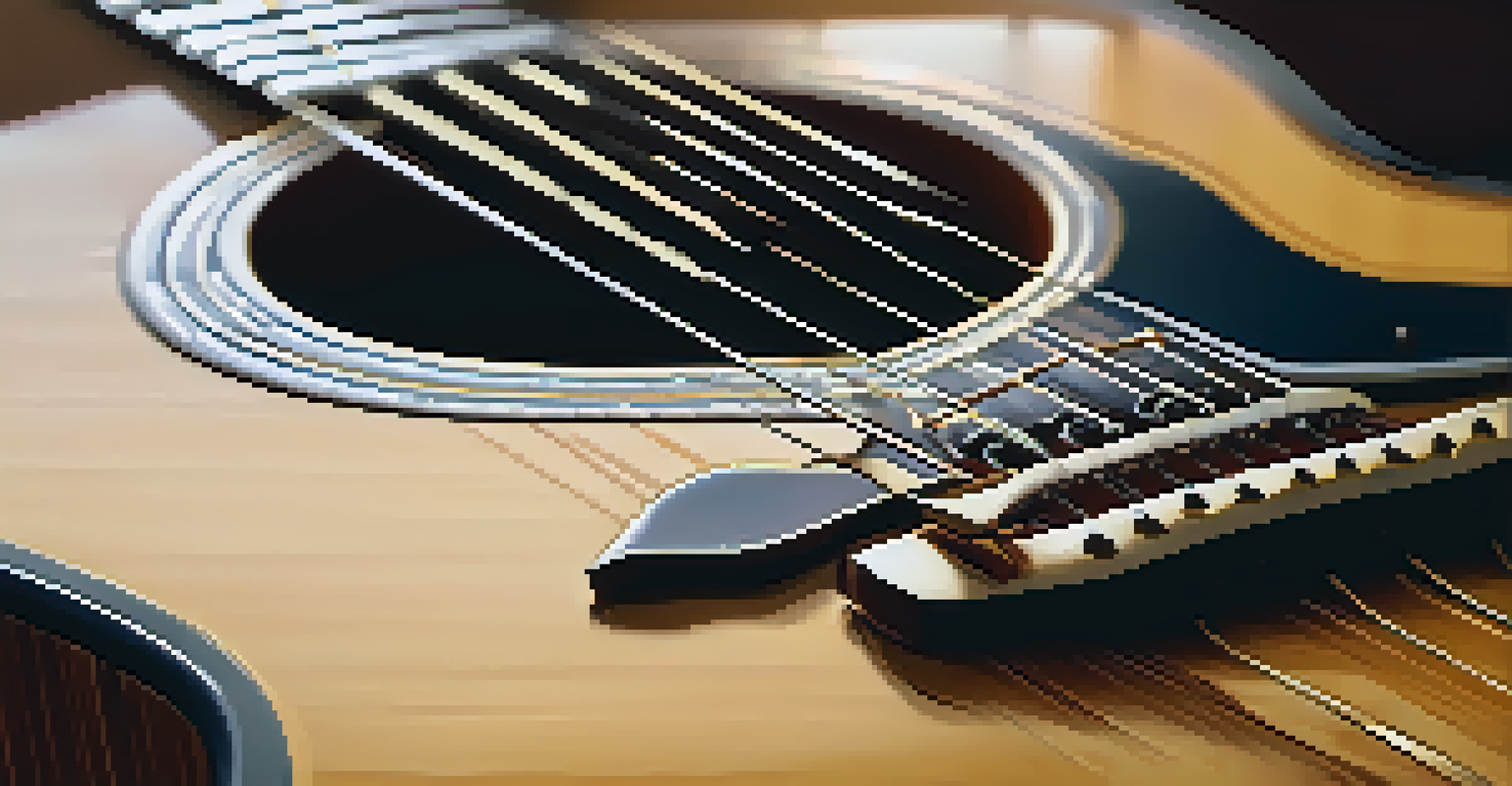The Role of Chord Progressions in Guitar Improvisation

What Are Chord Progressions and Why Do They Matter?
Chord progressions are sequences of chords played in a piece of music. They establish the harmonic foundation, guiding the listener's emotional experience. Understanding these progressions is crucial for guitar improvisation, as they provide a roadmap for your solos.
Music is the shorthand of emotion.
For instance, a simple progression like C-G-Am-F can evoke feelings of happiness, while a more complex one might create tension or suspense. By recognizing these patterns, you can anticipate where to take your improvisation creatively. This awareness allows you to connect more deeply with the music.
Ultimately, chord progressions serve as the backbone of a song, and knowing how to navigate them can elevate your improvisational skills. They guide your phrasing and dynamics, making your playing not just more structured, but also more expressive.
Common Chord Progressions to Know
Some chord progressions are more popular than others, and knowing them can significantly boost your improvisation. The I-IV-V progression, for example, is foundational in rock and blues music. It consists of the first, fourth, and fifth chords in a key, providing a familiar backdrop for solos.

Another classic progression is the ii-V-I, often found in jazz. This sequence offers a smooth transition between chords, allowing for more complex improvisation. Recognizing these common progressions can help you identify opportunities to insert your solos seamlessly.
Importance of Chord Progressions
Chord progressions form the backbone of music, guiding emotional experiences and enhancing improvisational skills.
By practicing these progressions, you can develop a stronger ear for music. You'll start to hear when a particular progression is used, enabling you to improvise more confidently and creatively, regardless of the genre.
How to Use Chord Progressions in Improvisation
When improvising, you can start by outlining the chord tones in your solos. For example, if you're playing over a C major chord, emphasize the notes C, E, and G in your phrases. This creates a sense of harmony and makes your improvisation sound intentional.
Improvisation is not a skill, it is a way of life.
Another strategy is to use arpeggios, which are notes played in sequence from a chord. They add a melodic quality to your improvisation and help you navigate chord changes effortlessly. Consider practicing arpeggios over common progressions to become more fluid in your playing.
Lastly, don't forget to experiment with scales related to the chords. For instance, if you're playing over a G major chord, you might explore the G major scale or even the E minor scale. This allows you to create diverse musical ideas while staying true to the underlying harmony.
The Emotional Impact of Chord Progressions
Chord progressions can set the mood for a piece, making them a powerful tool in improvisation. For example, a minor chord progression often invokes feelings of sadness or introspection, while major chords can bring about joy and brightness. Understanding this emotional language can help you connect with your audience.
When improvising, think about the emotions you want to convey. If you're playing a sad song, stick to minor chords and progressions to enhance that feeling. On the other hand, if you're looking to uplift, major progressions should be your go-to.
Common Progressions to Learn
Familiarizing yourself with popular chord progressions like I-IV-V and ii-V-I can significantly boost your improvisation capabilities.
By aligning your improvisational choices with the emotional context of the chord progressions, you can create a more compelling performance. Your audience will feel the connection, making your playing more memorable and impactful.
Practice Tips for Mastering Chord Progressions
To become proficient in using chord progressions, consistent practice is key. Start by playing along with backing tracks that feature different progressions. This will help you get comfortable with improvising in various musical contexts and styles.
Another effective method is to isolate specific progressions and create short improvisational phrases over them. Record yourself playing and listen back to identify areas for improvement. This reflective practice will enhance your ability to create melodies that complement the chords.
Lastly, don't shy away from collaborating with other musicians. Jamming with others allows you to apply what you've learned in real-time, adapting your improvisation based on their playing. This experience can deepen your understanding of chord progressions and their role in music.
The Role of Rhythm in Chord Progressions
While chords provide the harmonic foundation, rhythm is equally important in shaping how those chords are perceived. The way you strum or pick the chords can create a completely different feel. For instance, a steady strumming pattern can give a song momentum, while syncopation can add excitement and surprise.
Incorporating rhythmic variations into your improvisation can make your solos more dynamic. Try experimenting with different rhythms over the same chord progression to find what resonates best with you. This exploration can lead to unique phrasing and unexpected musical ideas.
Emotional Connection in Music
Understanding the emotional impact of chord progressions allows you to convey feelings effectively through your improvisation.
Finally, pay attention to the rhythm of the underlying chord progression when improvising. Matching your melodic ideas to the rhythm can create a cohesive sound that enhances the overall musical experience. This attention to detail can set your playing apart.
Exploring Advanced Chord Progressions
Once you're comfortable with basic chord progressions, it's time to delve into more complex ones. Advanced progressions can introduce various chords, such as diminished and augmented chords, which add richness and tension to your improvisation. These nuances can make your playing more interesting and sophisticated.
For instance, the jazz progression I-vi-ii-V introduces a cycle of chords that leads back to the tonic. This creates a sense of movement that can be exciting to navigate during improvisation. By mastering these advanced progressions, you'll expand your improvisational vocabulary significantly.

As you explore these complexities, remember to take your time. Incorporate them into your practice gradually and pay attention to how they affect your improvisational style. With patience and creativity, you'll find new ways to express yourself through your guitar.
Combining Chord Progressions with Other Musical Elements
Improvisation isn't just about chords; it's about weaving together different musical elements. Consider incorporating dynamics, articulation, and phrasing into your solos. For example, using softer dynamics during a verse and building up during a chorus can enhance the overall impact of your improvisation.
Additionally, think about how melody interacts with harmony. When you improvise, allow your melodies to rise and fall in relation to the chord changes. This interplay creates a richer listening experience and keeps your audience engaged.
Finally, remember to listen to other musicians and analyze how they combine chord progressions with other elements. This observation can inspire your own improvisational style and help you discover new techniques. The beauty of music lies in its endless possibilities, so keep experimenting!